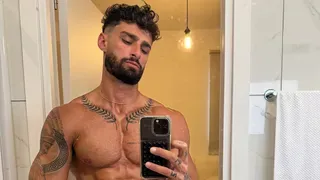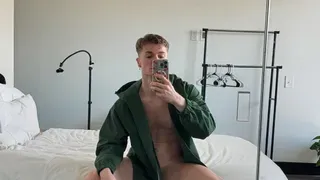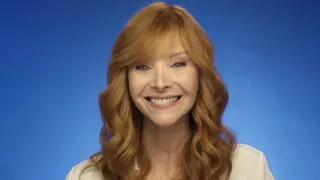February 1, 2010
Bisexuals on television :: a lopsided trend
Padraic Maroney READ TIME: 12 MIN.
The number of LGBT characters on television has always been a problem - they have yet to reflect a number and diversity they have in the real world. But an even bigger problem is there lack of sexuality, especially with gay male characters. They may crack one-liners and be everyone's BFF, but what happens in the bedroom, stays in the bedroom.
There are exceptions -- Queer as Folk pushed the envelope and the British series Torchwood continues to; but QAF was premium channel programming and Torchwood is from the BBC, notorious for adventurous adult programming. Here in the States things are different. Even on a seemingly progressive show like Desperate Housewives, the token gay couple - who weren't even introduced until the fourth season - has rarely, if ever, talked about their relationship, let alone be seen in any intimate scenes. Unlike, of course, Eva Longoria Parker's romps with hottie Jesse Metcalfe during the first season that established the show's openness towards (heterosexual) hi-jinxs.
About the time that Housewives introduced Bob and Lee to Wisteria Lane, an interesting trend began to emerge across the networks: the emergence of the bisexual, specifically women who like women and men. And while two gay men can't kiss on television without it appearing that the End Days are upon us (witness the response to the proposed Superbowl Mancrunch.com ad), women are seen locking lips in full close-up.
Authentic inclusion or cop-out?
House features Olivia Wilde as Dr. Hadley, also affectionately known as 13. Melrose Place has Katie Cassidy as Ella Simms. Grey's Anatomy has Callie (Sara Ramirez), who has dated both men and women. But while these characters are welcome, the unevenness of the male to female ratio of bisexual characters is lopsided - there are virtually no bisexual male characters.
With such a difference, the question begs to be asked - is the integration of bisexual characters into network television an authentic inclusion based on story needs or is it a cop out to have an LGBT character who is less threatening because they're not exclusively gay? Story continues on following page.
Watch Olivia Wilde's kiss on House.
Bisexuals marginalized
While it seems at times that anything a gay person does on television can be controversial (Adam Lambert, we're looking at you), having a bisexual character can be even more because neither the straight or gay community has fully embraced the bisexual label.
"Bisexuals still feel marginalized and misrepresented," explained Dr. Gabrielle J. Forman, an LGBT affirmative psychotherapist at Los Angeles' Center for the Psychology of Women. She adds the stereotype still persists that "Bisexuals are greedy, out having as much sex as they can. While some may be polyamorious, it's more common to be a serial monogamous."
By having a bisexual character can give the networks a safety net - and sometimes and easy out. They are able to incorporate a LGBT character, but if there is an outcry from viewers and sponsors, writers can pair the person into a straight relationship without having to completely rewrite history.
"It's a just a general issue with how network executives perceive the audience," said Martin.
The initial buzz that comes from a character having a same sex fling or having a bisexual character is still a guarantee for a show to get back some water cooler talk. When the new version of Melrose Place first premiered this past fall the media latched onto the idea that Cassidy's Ella Simms was a bisexual. In response the actress herself had fun with the questioning by saying that Ella is "try-sexual" -- willing to try anything.
Unaware, Cassidy's response plays into the bigger problem that networks play into the stereotypes previously mentioned about bisexuals.
"The recent crop of bisexual characters on television represent little more than a reprisal of offensive bisexual stereotypes. The networks love the 'open-endedness' of what they perceive of as bisexual sluttiness that basically reduces bisexuality into a series of unexpected sexual cliffhangers, which is not an accurate depiction of how bisexuals make life choices," posits Dr. Emma Crandall, a Marion L. Brittain Postdoctoral Fellow at the Georgia Institute of Technology.
"Still, writing bisexual, rather than gay, characters, allows networks to play it safe and capitalize on sexual exploitation without the obligation of producing characters that actually represent the diversity of human sexual experience," she continued.
"Homosexuality is still just too challenging to see on the big or small mainstream screen unless it comes with a great deal of traditional, old-fashioned, and recycled packaging." Story continues on following page.
Watch Olivia Wilde and Misha Barton's kiss on The OC.
Frat boy’s fantasy
Think for a second if you can think of a bisexual male character on television. It's harder than you think. They aren't nearly as prominent as their female counterparts. But it shouldn't be any surprise anyone as networks are always trying to get the widest audience without alienating anyone. There isn't evidence that women find two men together to be a turn on, but any straight college aged boy will tell you they dream about seeing two girls.
"What's could be more titillating to straight guys than two women," asked Jason Stuart, the national chair for the Screen Actors Guild's LGBT committee. "It's a way to get ratings. They have been doing it all the way back to Basic Instinct."
Author Joseph Picard saw this firsthand when his novel Lifehack, which has a lesbian protagonist named Regan and features her bisexual ex-girlfriend, came out and was marketed toward straight men.
"If I made it about a gay guy, it would have caught less fans," Picard explains about how much the character's gender would have affected the book's success.
For the most part, many of the women who are cast in these roles are attractive. But when push comes to shove and the novelty - or ratings - fade, the character will go back to dating almost exclusively members of the opposite sex.
"Often times it's a wash because they aren't depicted as being "authentic bisexuals". They state it, but their actions imply heterosexuality," notes Al Martin, a sociology professor at DePaul University who also teaches media studies. "Rarely, if ever, do we see the homosexual end of the spectrum of sexuality."
One character that has traveled the spectrum is that of Dr. Hadley on House. When the producers of House conceived of the character called Thirteen her bisexuality came organically from her personality. The character was originally thought up as part of a Survivor-type competition on the show as Dr. House looked to replace his old team with new members.
"[Thirteen] is a little unknowable and for lack of a better word, slippery," explained supervising producer Liz Friedman. "It kind of came out that. She doesn't like to be in a box."
Over the last couple seasons since Olivia Wilde joined the cast as Thirteen she has been seen intimately with both women and men, including a relationship with series regular Omar Epps' character. The relationship brought to light the fear that many viewers have with bisexual characters.
"There were people that weren't happy. Some people were upset with her dating men because they were worried it would erase her romances with women," the producer recalled.
That hasn't happened and the show was even praised early on in the character's tenure by website AfterEllen.com for an episode involving a one night stand with Dr. Hadley and a woman, who she ends up having to take to the hospital after the woman has a seizure. It gave the show an opportunity to explore that aspect of the character, but House is different from other shows because they only examine the personal lives of their characters when it fits the confines of the narrative.
"We do personal stories, but it they have to be accessed through the cases. First and foremost, Thirteen is a doctor," Friedman said about the show.
And even Wilde, who earlier played a bisexual as the love interest to Mischa Barton's Marissa on The OC, notes how television favors same sex women over same sex men.
"When I kiss a girl for a part, people think it's sexy. But if two guys kiss, suddenly there's a backlash. It's a double standard. Honestly, I think we're all bisexual in some way," says Wilde said in an interview with the website TV Addict.
"I think it's high time people start to get used to alternative lifestyles on television," she continued. "Whether it's sexuality or whatever. People are still getting used to interracial relationships on television and of course in the world we live in now, it's time for people to become accustomed to that too." Story continues on following page.
Watch this clip about Omar Epps and Olivia Wilde from House.
Where are the men?
With the controversy that comes along with have LGBT characters on a show, making sure that they are not going to be offense is something producers are careful about when introducing the characters.
While Picard, who is heterosexual, was writing Lifehack he wanted to make sure he was giving an accurate portrayal and not something that was demeaning the author went onto Internet message boards to survey postings on the subject. While the feedback came back positively, he unintentionally fed into the promiscuous stereotype with the ex-girlfriend.
"I didn't set out to offend," explained the sci-fi writer. "I fed into a negative stereotype - but I didn't know until after. Chris is a little tramp. Perception is that bisexuals want to fuck everything."
House has multiple lesbians working on the show, which allowed writers to pull from their experiences for information. To do her homework, Friedman jokes, "I went out and slept with a lot of men." Friedman co-wrote Lucky Thirteen, the one night stand episode that deals with the character's bisexuality.
An Absence of Bisexual Male Characters
While Friedman and the crew working on House have been commended for how they have handled Thirteen. As much as they have done to flesh out the character, Dr. Hadley still falls into some of the stereotypes that television bisexuals often fall into.
"What you see on TV frequently is attractive, white girls whose bisexuality is limited merely to making out with other attractive white girls. It marginalizes women's sexuality and makes it a spectacle," says pop culture writer Kelly Dunleavy.
There is a dearth of male bisexual characters can be added into the mix, networks need to be more comfortable with having male homosexuality.
"By not presenting male bisexuality, it's more of a cop out," said Dr. Natalie Wilson, a media scholar at Cal State San Marcos.
Is this just an American problem? Perhaps. Since 2006 the Britain's BBC has aired the science fiction series Torchwood, which is currently in production for its fourth season. On the show -- set in the 51st century -- John Barrowman plays the bisexual Captain Jack Harness in charge of a team from a covert agency called the Torchwood Institute, which investigates extraterrestrial incidents on Earth and scavenges alien technology for its own use. The sexuality of the characters is fluid and there has been no hesitancy on the producers' part to show mano-a-mano romance. Plans are in the works for an American spin-off, whether the open bisexuality will be part of its mix remains to be seen.
Still on American prime time gay men are largely used for laughs -- the witty, charming, urban hip stereotype whose personal/sexual life is kept way off camera. The sad truth is that networks have yet to embrace a gay character with a healthy sex life.
"I think that it is always easier for the media to "sanitize" the characters, and having a bi character ( especially if it is female ) titillates without having the show, or the network deal with the real substance of gays and lesbians," said Gary Baily, former President of National Association of Social Workers. "I think that there is a level of discomfort in many instances unless the gay male character(s) especially are played for comic relief as in Modern Family."
SAG's Stuart agrees, saying that the lack of gay characters is primetime is a bigger departure from reality than anything else that the show's writers might be able to dream up. "Imagine any hospital without a gay nurse. Christ, that's where they're getting out of reality," says the actor with a laugh. Story continues on following page.
Watch this clip with John Barrowman from Torchwood.
Cable networks lead the way
Progress will be made, but it will most likely be made from the smaller networks first. With many of the bigger networks owned by large conglomerates, the bottom line will usually win out.
"Lots of times smaller networks are more progressive, like Fox 20 years ago. Younger networks are able to push the envelope more than conglomerates," explains Martin.
If looking from a historic standpoint, the fact that bisexuals are being included a semi-regular basis is a step forward to including all members of the LGBT community onto network television. While there is plenty more work that needs to be done, their inclusion shows an effort by producers, writers and network executives.
"I think that there are a number of positive aspects to having bisexual characters of both genders on television. First, any non-heterosexual character on a mainstream show has to be indicative of a shift towards acceptance of the LGBT community. Secondly it is my belief that sexuality is fluid - not for everyone, not all of the time - but that it exists on a spectrum, and bisexuals must, therefore, be part of that spectrum," said Miranda Sajdak, an out filmmaker. "They certainly deserve representation - hell, if I want lesbians to be represented, I can hardly complain when bisexuals are."
There are other positives that come from having bisexual characters on television. By making the characters more visible it affects how people view actual bisexuals and it will widen their visibility.
"It's good if you take into account the socialization factor," explained Martin. "[These shows] expose young viewers who don't have contact with the GLBT community to see themselves and know their not alone."
Progress will be made, but it will most likely be made from the smaller networks first. With many of the bigger networks owned by large conglomerates, the bottom line will usually win out.
"Lots of times smaller networks are more progressive, like Fox 20 years ago. Younger networks are able to push the envelope more than conglomerates," explains Martin.
Along with the smaller networks like the CW, cable might also be the answer. Cable has always been looked as leading the way to having edgier material. But only time will tell if they will include truer and more frequent portrayals of bisexual characters, as well as all members of the LGBT community.
Watch this clip with John Barrowman from Torchwood.






